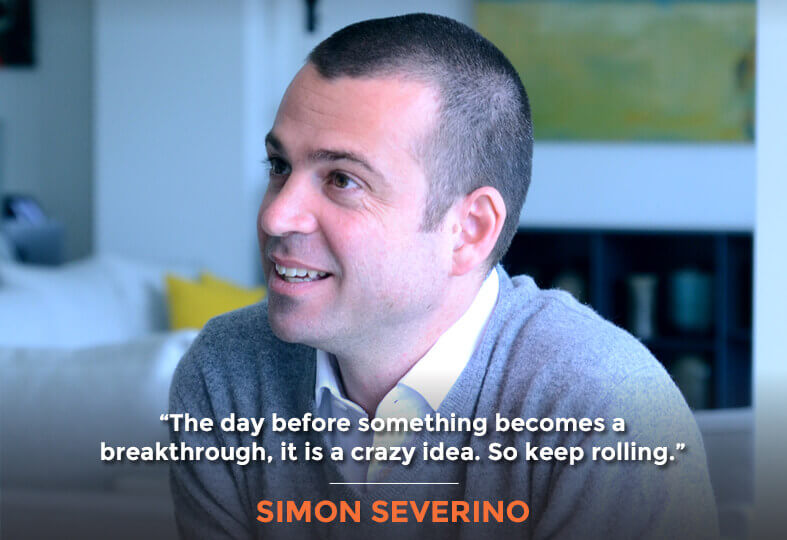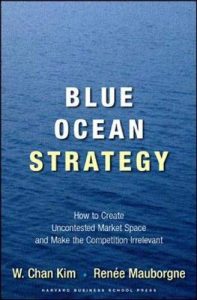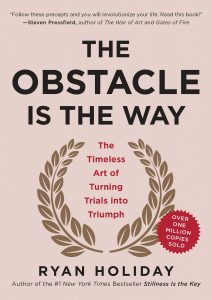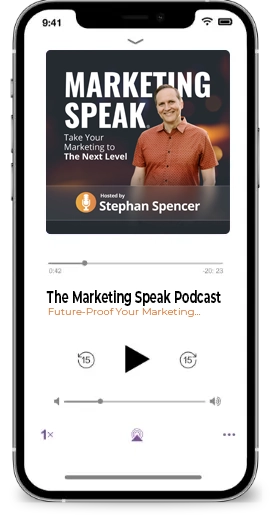My guest on today’s show, Simon Severino, recently tweeted, the day before it becomes a breakthrough, it is a crazy idea. So keep rolling… Indeed! In his business Strategy Sprints that promises (and delivers on) doubling the revenue of SaaS and Service Businesses in 90 days, he has become a master of distilling the unique offering that his clients bring.
In today’s show, we talk about the different templates that Simon and his team use with clients to measure KPI’s and determine where they stand with the competition. And he makes a really important distinction between just knowing who your competitors are vs. also understanding what other options the potential client has. Once you determine where you are winning, you don’t have to reinvent things—you simply need to double down on your strengths.
We talk about many powerful templates—simple, intuitive spreadsheets that allow you to, in effect, draw your own vision of success, and map out how to get there. His business truly embodies the quote, “what gets measured, gets managed.” This episode is a must for anyone who wants to land better clients and gain their time back, so without any further ado, on with the show!

In this Episode
- [00:29] – Stephan introduces Simon Severino. Simon and his team of Certified Strategy Sprint coaches only do one thing: double the revenue of SaaS and Service Businesses in 90 days.
- [05:19] – Simon explains how to use Strategy Sprint’s Equalizer Template.
- [11:55] – Simon describes how they onboard a company to do the Sprint process and assess their existing systems.
- [17:17] – Simon talks about the free public mastermind they created back in March 2020 to serve the community and help each other during the pandemic’s difficulties.
- [23:24] – What is the Strategy Sprint’s Sales Tracker, and why is it the most transformative out of the 247 templates?
- [28:28] – Stephan and Simon discuss the importance of having a sales script in creating a good flow of conversation with a prospect.
- [34:07] – Stephan shares Taki Moore’s concept of stretching the gap for your customers as a sales approach for them to be interested in what you offer.
- [39:10] – Simon indicates what Peter Drucker said about decoupling the performance system from the incentive system to avoid corrupting both systems.
- [45:03] – Simon talks about reading all their Sprint clients’ feedback on their NPS scores and a rule he has for himself on dealing with all of their responses.
- [51:30] – Visit Strategy Sprint’s website at StrategySprint.com to grab their free tools and templates and learn more on how to double your revenue in 90 days.
Transcript
Simon, it’s so great to have you on the show.
I’m so excited to be here. Hello, everybody. Hello, Stephan.
Let’s start by addressing this head-on; what you do for your business is to help companies and entrepreneurs double their revenue in 90 days. How the heck do you do that?
It’s not that hard. If you are 17 years in business consulting, you see some patterns, and you see the quick wins, and you know how things should generally work with each other. Operations, sales, and marketing need to work well together. And you have a lot of business experience, I have, and when we look at a company, we immediately see two or three things where integration is not working. So we work intensively, and we work only one-on-one. We don’t do group coachings, we don’t have training programs, only one-on-one, very intense for a full-quarter. We go deep, help them improve their offering, make it more relevant, be more integrated with what they tell others about the offers of the whole marketing system, and be more integrated with how they bring relations to close the sale system. We have 274 templates, which also help because you get started faster.
Let’s talk about these templates. How does this help? Are these standard operating procedures? Are these worksheets? Give us some examples of these.

Yes, we have eight types of templates. Some of them are just checklists or swipe copies for emails or spreadsheets. I will share one of them fully with you, and listeners can grab it afterward because it’s super relevant right now in the pandemic to stay in the game. One example is that it’s a spreadsheet, and it boils down to how you can find your blue ocean. I guess most people listening right now have read the book Blue Ocean Strategy. How can you swim free from the competition a little bit, be less comparable so that you can get up with your prices, you can have a better position? Now that works, and their examples are all big companies, but does it also work for the small ones? We boiled it down and created a simple spreadsheet that you can use in half an hour with your team. If you go through those five steps, you will find your uniqueness, and now you can start acting on it, doing more of what’s your core, your essence, and doing less of everything else, which means also spending less time, less money, less attention on all these other things. That’s an example; a spreadsheet.
So that’s a very helpful template or checklist. What would be an example of something on that checklist that would help the listener go through with their team, this process of identifying that Blue Ocean Strategy?
Many people think about their three competitors, but your client doesn’t think that way.
If we deep dive into that, we call it the Equalizer Tool because it looks like you are a DJ, and you are putting more of something here, less of something there, more here, more there. “Can I take 200 euros from here and move them there?” “Oh, if I automate this part, I can take some money from here and put it into there.” That’s why I call it the Equalizer. It’s five steps, you go in there, copy the spreadsheet, and then the first thing it asks you is, “What’s your competitive arena?” Who are your three main competitors, but also alternatives? List the behavior alternatives of your clients. This is something different, but it makes a huge difference. Many people just think about their three competitors, but your client doesn’t think that way. For example, if your offer does not exist, what else can they do? From their perspective, “Hey, Mike, the intern can do it. I can hire somebody to do it. I can do nothing.” These are their alternatives. So the competitive arena is your three competitors. You list them out.
But also, what else can the client do? And so you list that too, and that’s your competitive arena. Then the second step will ask you to put in, “Where do they invest in right now?” Where are they putting the money? For example, it’s in technologies or a data-driven dashboard, or AI. And then you grade yourself in these features where you are winning, you give it a 10, and where you’re losing, you give it a 1, and then where you are “meh,” you give it a 4 or 5 or 6. Now, this spreadsheet will cluster for you, and the output will be on the left side. It will cluster where you’re losing. You are not winning the game in that field, so cut expenses there. In the middle, okay, you are okay, others are okay. If everything’s wiggling around there, reduce your expenses there. And then on the right side, you will see this is right now where you are winning. You gave it a 10. So double down on that. Take the money from the left side, right now in this month, make your budget accordingly. So act accordingly. You are already winning there. That’s your uniqueness. And this is where you are winning right now. So don’t reinvent things, don’t start new things, just double down on this one.
The day before something becomes a breakthrough, it is a crazy idea. So keep rolling. Share on XI always think it’s a silly exercise to focus on your weaknesses to shore them up when you have strengths, and you aren’t spending time building up those strengths even further.
Absolutely. Many people right now, especially in the marketing field, there are so many opportunities, right? You could go and do a LinkedIn outreach, and you could do an Instagram push. You could do a five-day challenge. You can do a hundred things, and they all sound interesting and worth exploring. Maybe they are, but you are sitting right now on a goldmine of things that already work. So do them first.
Right. And what would be something for your business that you double down on based on taking your own advice?
We do this every month for around an hour, and it takes us one hour as a team. We go through exactly this one. So we only share the templates that we use ourselves. Otherwise, we don’t share them. This month, we did it with our team. One of our team came up with the idea that we are the only people who have CEO-to-CEO coaching. I wasn’t aware of that. What happens when you do the Equalizer with your team is that you start discussing, “Okay, who’s the competition right now? What else can your customers do? What do we stand for?” Now your team will see things that are worth discussing. So this idea for me, for my marketing activities, was a very valuable idea. And so my colleague said, “Simon, we stand for CEO-to-CEO coaching. Nobody has that. Our three competitors don’t do it. They send you their junior consultants. They send you people who are 25 years old, and we send CEOs who sold six companies for great prices. So that’s a key differentiator.” And I was like, “Oh, I was always thinking of speed as a key differentiator, and our templates, etc., I wasn’t seeing that thing that was lying there, which is so important.” Of course, it changed the way we budget. Now, when I hire people to be a sprint coach, I look for different things. These criteria are now number one, and other things like skills, or region, or capacity become less important. It changes all our hiring processes, and also our marketing copy.
We are the only people who have CEO-to-CEO coaching.
That makes sense. It’s great. When you do these hour-long processes in your own company, do you involve other team members? How many people are involved?
We involve five people because we think it’s a great group to have between 4-6 people in such a session. We are five people, and it takes us one hour. If you have more complexity, you can bring in up to eight people, but then take two hours, and especially the first time you do it, take at least two hours because you will be discussing the fundamentals of your business. So you will have very different perspectives, or you have to even explain some things to people who are newly on board. So the first time, give it at least two hours. We are used to it, and it’s a habit for us. So one hour, five people, that’s what works for us.
Great. That’s based on like a Google Sheet that is a template, and then you save it to your Google Drive. What would be something in a different structure other than a Google Sheet out of those 274 templates? For example, do you have any dashboards with Google Data Studio? Or do you have any ProcessStreet or SweetProcess? Those are two apps, two software as service tools, any templates in either of those tools?
One of our dashboards is called the Weekly Update. This is also something that people find helpful. In the beginning, when somebody sprints with us, the first week is diagnosing the system. We go through the 11 elements of an invincible company from vision strategy, execution, offer, down to sales, marketing, team, mindset, culture, everything. Then we see where they are, where they see the bottleneck, where they want to move forward. Based on that, we ask them, “Okay, you can now pick three KPIs. Pick three that will tell you 80% of the story you need to know.” And you know, KPIs, you can have many, but if you just pick three, usually one is about revenue, number of new clients, number of close deals. One is around client happiness, the NPS score, or number of referrals via clients, or the number of referrals via colleagues. And the third one depends on their niche or their context. Sometimes it’s the churn rate or the number of deals closed. It can be different. If it’s a SaaS business, it’s usually the churn rate, how many people you lose in this cohort over time.

With these three numbers, we try to have 80% of the story that we need to know. So we need to know, are we going in the right direction at the right speed, and which three KPIs will tell us this. And then we help them. It takes again around one hour to filter out the main three KPIs. And then, we create a dashboard for them that they will see every seven days. So 12 times in one sprint, they will update that dashboard. And so you always see where you’re heading to. Because I was missing that when I had great business coaches, and they were so influential and a key to my journey as an entrepreneur. They were absolutely important, but they never had something that gave me an orientation to where I am right, if I’m headed in the right direction and at the right speed. So we created it.
That’s awesome. What are your three KPIs for your company?
Right now, the first one is revenue; the number of new clients closed this week. The second one is the number of subscribers this week coming into our email service. It’s our newsletter, but we call it the email service because it should serve somebody. Otherwise, it doesn’t go out. And the third one is the number of gigs. And gigs means Simon is speaking on some sort of stage. For example, this one is a gig of Simon, Simon on a podcast.
Okay. Was this different, let’s say, a few months ago? Did you have different KPIs back then?
Yeah, they changed in March, and they changed last year. So they change regularly, I would say every eight to 12 months, we have some tweaks there. And especially when something like a pandemic happens, we have to adapt.
Change your KPIs regularly. Especially when something like a pandemic happens, you have to adapt.
Yeah. And how did you adapt to the pandemic?
The first thing was that everything had to be online. We still had some elements that were event-driven. We would have 200 people in a room and use this energy at specific points of the transformation, just to get alignment, to get that energy, etc. So we had to rethink how we can do this entirely online. We changed some parts of the product and changed some parts of fulfillment; now, customer service is 100% remote. That changed the way we hire. Also, because we were not there, we had to think of how the client can get hold of us much quicker—again, changing the product. So we created something like Spiderman and the chair guy so that they can reach us directly now. Before that, you would have to wait, I don’t know, 2-3 weeks until your sprint coach flies to your city, and then you will have a workshop of three hours, six hours, eight hours. All of that is gone, and now you have 24/7 access to your sprint coach. And it’s like Spiderman and the chair guy. So right now you have to think, should I click the left door or the right door? I don’t know, what should I do? And you want it now. You don’t want it to be two weeks later at a workshop, right? And so we have to recreate the product so that you can have 12, 15, 16 of these moments. At that moment, when you need the decision, you need your coach and not vice versa. So we also rebuild parts of the product.
Did you change your pricing as well?
We changed the pricing in the first month. We did a lot of things for free in March and in April. We created a whole mastermind, we didn’t change the price, but we did work for free in March and April a lot just to serve the community, to make sure that everybody has space to digest together this thing that nobody knew what’s going on, right? So we created a free mastermind for everybody. It was a public mastermind for free every Monday in March, April, and May. And I was there. And it was called Managing What Is.
You can do a hundred things in marketing that sound interesting and worth exploring. But if you are sitting on a goldmine right now that already works, you’ve got to focus on it first. Share on XYou did this for not just your clients but anybody on your network who heard about it?
Everybody, we had four continents in there.
Amazing.
Yes. And we had airlines discussing there, automotive people discussing with consultants. It was amazing because we were all asking each other, “Hey, what about your country? What about your sector?” And we were frozen, everybody was frozen, and we were unfreezing during this discussion bit by bit. “Oh, hey, I have tried that. What did you try?” There were resources, of course, where to get stimulus, etc. So it was quite a vital period of the year. And we just wanted to be there. We wanted to have the money off the table and just to be there for the community.
Did you have some huge companies in this process as well?
Yeah. Airlines had some significant shifts from everything, flying people were gone, but flying stuff was still there. And so they had to manage this transformation.
And you are connected somehow to Google Ventures or some VC firm or some really big SaaS companies?
So one thing that I like is joint ventures. I call it “growth via collaborations.” And we live this. And so once a year, we do a big collaboration with a big partner. So right now, our big partner is Google. Google has a program called Grow with Google. And so they have some excellent stuff to share in terms of data and tech. They need a partner with SMB knowledge, entrepreneurial knowledge, and coaches to help SMBs grow, especially during this year. So we did a joint venture, and we are sharing our templates and our coaches. They are sharing their audience and their tech. And together, we help SMBs grow. That’s our main joint venture of this year. I also do small cross-promotions with colleagues. I went up to 24 per year. So my goal for this year, 2021, is to have 24 cross-promotions. I promote colleagues, and they promote me in their email newsletter. This is one way of a very elegant, very human, very respectful, and natural way of growing an audience. So I like what I call growth via collaborations, just putting together the resources and making the best for everybody.
The best things are absolutely ordinary.
One example of somebody who’s also in the same group that we are in JVMM, Joint Venture Mastermind, Tom Poland, was a guest on this podcast, and he does a lot of these cross-promotions where he’ll team up with somebody often in the group in JVMM. And we’ll have them promote his webinar, and he’ll encourage their webinar. And he manages to fill quite a lot of webinars through this joint promotional approach.
Absolutely. Last week, I promoted Lisa’s book launch from the JVMM. Today, I promoted Dov Gordon’s webinar, and he’s promoting mine. This is a wonderful way to nurture relationships and also to create win-win situations.
Speaking of Dov Gordon, that’s a great interview to check out because it’s pertinent to our discussion here. And Dov is just a super smart, great guy. So I’m curious to hear some template out of your list that is so out of the ordinary and something that you’ve not come across anywhere else that would, I don’t know, get our listener thinking differently?
That’s a great question because they are all ordinary. The best things are absolutely ordinary. And they work over a thousand years. In the last 17 years, I went from New York to Beijing to consult companies, and I was in the boardroom of the BMWs, and the Boehringer Ingelheims, and of the really smart boards. And I have seen some stuff where I thought, “Oh, this is new, this is exciting.” And I got certified, I used it, I did it. But 17 years later, when I look back, the most impactful things were the simple things. And so the 274 are just the evergreens, the simple stuff, like a competitive analysis, like finding out who you really seek to serve and going deeper, going five levels deep when you share your sales numbers with your people, to share them transparently every seven days.

Let’s talk about the Sales Tracker because I think that’s the most transformative one that gets the most resistance in the first week. So people say, “Okay, I want to double my revenue. Let’s do this.” We start with the first week, and we do a diagnosis. Outcome; three sprint calls, three KPIs every seven days, we’ll measure. Come week one, the coach says, “Okay, show me, how many discovery calls did you have last week, and how many discovery calls will you have next week.” And here is where the resistance starts every time. “Well, you know, my CRM system is HubSpot. And it just tells me that every 30 days,”–this is just one example. But I could tell you 170 examples every week, and people are creative in telling us why it’s not possible to know all the sales numbers every seven days. So this becomes the work. Because when you have an obstacle, the obstacle becomes the way. Now it becomes the work to see, okay, where are we? What’s the flow of information right now? What are the significant things to know? And these are the important things to know.

I’m curious, have you read the book, The Obstacle Is the Way?
Of course. Ryan Holiday, beautiful book. I was born in Rome, so I read Marcus Aurelius and Epicurus because the stoic philosophy is actually for entrepreneurs. A very helpful, very positive, very simple philosophy. Again, something really simple. In the end, it’s control what you can control. It’s only three things, everything else you cannot control, don’t bother.
Yeah. Well, there’s the Serenity Prayer too, which is relevant to that idea as well.
Exactly. You see evergreen, simple evergreen.
Okay, so I interrupted you. So please keep going. This is fascinating. So this idea of a sales tracker, and getting past excuses, and then being open and willing to be transparent with your entire team weekly. I could see how there would be resistance to that.
At the same time, resistance becomes the topic of the sprint conversation because they have one coaching call every week. And in that call, you go exactly there. So in week one, it’s always, “Yeah, but it doesn’t work for us. We cannot know how many discovery calls we will have next week.” “Okay, then let’s go to the reporting system. Which information do you get reported every seven days? What data do you have? How many people were on your website last week? How many of them are interested? How many of them are just slightly interested? What’s the one template you have for slightly interested people, and you will follow up? Do you have a retargeting campaign? What’s the one action for the highly interested people and are ready to buy or semi-ready, they are 60% ready to buy? How do you bring them from 60 to 80? What’s the one tactic that is automated?” They usually don’t have it, so we create it with them. So we create something that brings people from 60% to 80% ready. And then, when they are 80% ready, how do you move them to close? And all these conversations are just triggered by one simple spreadsheet that’s called the Sales Tracker. The number of conversations of last week, how qualified were the leads? How many did you qualify in or out via your filtering system? How many did reschedule? How many did you close? And what did you learn?
That is an important question that I would say is not on most sales trackers or even if somebody has some reporting system or CRM. “What did you learn from that sales conversation that closed or didn’t close?” That is probably the most important question, isn’t it?
Control what you can control. Everything else you cannot control, don’t bother.
Yes. Maybe let’s share this with your audience. If you are not a sales pro, but you are doing sales, this is a very important question. First, track the number of calls that you have every week so that you can get to reliable estimation of how many you will have next week and next month. This is so important for your cash flow. This is so important for just the management of your business. Because you don’t have a business if you don’t have this info. You just have a great job or a series of jobs. But you have a business when you start getting data and knowing what’s coming next month.
There’s a quote that comes to mind that I think is misattributed. It’s, “What gets measured, gets managed.” Misattributed to Peter Drucker, I think it was a different person who said something slightly different. But I do still love that quote.
What gets measured, gets managed.
Absolutely. You want to get to a place where you have reliable sales numbers. Now, most people say, “Yeah, but I don’t have the data.” That’s how you start. You start by putting up a simple spreadsheet with these questions. So how many calls did we have? How many were rescheduled? How many did you close? And then you do a small after-action review. And that is, what was your goal for that call? No salesperson goes into a sales call without a goal, and you know exactly where you want to bring them. The second thing is, what happens or what is the delta between the goal and the output? And the third thing is, what do we learn? What do we do with it? We either now change the copy on the side, or change some technical parts or change the sales script.
Now many people might ask, “What is a sales script?” I will say it in a moment. But what do we do with this learning? What happens now? Because one thing needs improvement right now if you didn’t close. And now that we have said, what is a sales script? Yes, there is the sales script. It doesn’t mean that it feels unnatural to talk to your salespeople, and they go like robots over questions. You can be much more natural when you know the flow, and you have a blueprint of where you want to bring them in your head. So we teach a ten elements flow that is the perfect sales conversation. And it starts with specific elements, and it ends with the close or at least the next scheduled meeting in the calendar. But there are ten things to do, and the order is really important. Again, it’s nothing completely new, it’s something you would do in a normal, natural conversation you would do anyway, and it feels very natural. But you see these ten elements because you have the sales script. So you have this blueprint, and it’s like having a Google Glass, and you know exactly where you are going at that moment. You have a GPS for the conversation. And that helps you create a better flow.
Collaborations and joint ventures are excellent ways to grow a business. This is a very elegant, human, respectful, and natural way of growing an audience. Share on XI have a sales script myself. I don’t follow it strictly, but I do have elements that I know I need to incorporate. Or if I didn’t include, I know I missed it. So, for example, at the beginning of the call, I ask, “Is it okay if I can record the Zoom call, so I don’t have to worry about taking copious notes while we’re talking. It kind of takes me out of the flow.” Like, “Oh, yeah, sure.” Perfect. So now get that out of the way. I now have a recording I can refer back to in case there was something that I got confused by or I needed to review to put a proposal together. Really helpful.
Absolutely. We record every single sales call because we want to give feedback to each other. So, the whole sales team gets feedback internally. We give each other feedback on the sales technique. And we learn all the time. You can never be at a sales maturity level where you cannot learn. And you can always become better, more natural, and just close more. For example, we tell each other, “You were silent just for eight seconds, but our goal is to be silent for 15 seconds after we say the price.” There are specific moments where you have to be very precise, like at the beginning it is just a natural flow, the points are the 15 seconds after you say the price. This is critical because it’s all about emotions. Now you are excited; they are excited. You have to let them steer in that. And then the other part is when you describe the features. Of course, if you are excited about the features, you go and start talking spreadsheets, for example, but do not discuss features before you have clarified their pain points and what they want to hear. So don’t say anything before you don’t know what they want to hear. It’s like when you go with your kids to this school event where they all dance on the stage and show what they can do. So you will be bored most of the time. But then your kids come, and you are super alert and super attentive, and then the next kid comes, and you are bored again.

I can relate to that. Yes.
Don’t make that mistake in the sales call to tell all the features because they don’t care. They just care about their one pain point right now. So in the first part of the conversation, find that one pain point. And that’s what we call probing the sale. You just tell your three to five main benefits and then ask which one stands out the most. And then they will tell you, “Oh, it’s that. I want to save time.” Now, you only tell the time-saving deliverables. Then you probe again, and then you go into the time-saving features.
That makes a lot of sense. It reminds me of what Taki Moore teaches in his Black Belt program, which I was in. This is a great mastermind. Taki Moore also was a past guest, so definitely listen to that episode, listeners. So what I wanted to share about Taki in his sales approach is, he talks about accentuating or stretching the gap. Identify the pain point, then identify the ideal end state, the end goal or outcome thereafter, and accentuate or stretch the gap between those two points. So you dial up the pain and the urgency. So that makes it a lot easier to make a sale if they’re feeling the importance and urgency of the situation instead of downplaying it or brushing over it.
Absolutely. Some people call this “inflicting pain.” I think that’s not accurate because you cannot inflict anything that is not there. So it might be uncovering the pain and exploring the pain. Because if you do that right, these couple minutes are so well invested. Because 20 minutes later, when you discuss pricing, then that’s off the table. That’s not so important anymore because you are connected with a much deeper level of truth right there. And then everything else is just a tech detail.

It’s very good. So can you share an example of a recent situation, a sales call that you had, where you learn something since you’re always taking notes of things that you’re learning from each sales call, presumably, you’re learning all the time still, as you continue to hone and refine.
All the time. So every Monday, all coaches come together. Some of them do sales, I’m out of fulfillment, and I’m out of sales. And these were the best things that I ever did, fire myself from fulfillment and then fire myself from sales. But every Monday, we come together, and we coach each other. So the first round is clients, we go through all clients, “How is Lisa doing? How is Peter doing? How is Kevin doing?” And we go through the three numbers of the dashboard. So “Are the numbers going up or not? Why not? What do we need to build?”
The second part is just the sales team, and we give each other feedback. “Hey, in that call with Sydney, in minute two, he said that he is interested in that, and you just kept talking about the other thing. Do you see that? Now let’s pause.” We pause, we go there, we try to find out the body language. “How can you find that moment quicker to where you disconnected next time? Look at his body language. Look at yours. What was happening there? Where is he looking? What did he do with his pen or with his mug at that moment?” Find the cues that would tell you. And this is something where we are learning. Every week we are getting better, and we are learning from that. Because body language is something, it tells you everything, but you have to learn to read it. And so we’re learning to read it week by week as a human being, you learn all the time, right?

So the entire kind of committee or executive team or sales team, are they watching each other’s Zoom recordings and identifying those missteps and missed opportunities?
We record all, then we pick some, and we share them with the others. And we ask for specific feedback. For example, one of us was doing sales for Coca-Cola, Rudy, and he gets most requests. So people tag him in Slack and say, “Hey, look, I had this call with Rio. I’m not sure what to do in the next demo call. Can you please watch minute three and minute 18?” Or, “Hey, I was so excited about this, he would be a perfect fit, but he didn’t start with us. What did I do wrong? Hey, Rudy, can you give me some feedback?” But it’s very specific, and it’s not just like we put them all in and then guess. We target the coach inside the team that we want feedback from, and we support and challenge each other. So there is a healthy dose of competition and coopetition in our team, we want to be better, we want to be better every week. And we want to learn from each other.
Are there individual incentives or group incentives, or a combination of both? As far as like commissions or bonuses and things like that?
No, there are no incentives for this. I have a ton of experience with incentivizing sales for singular performance, group performance, etc. And because you said Peter Drucker, this is something that Peter Drucker said from the beginning, but nobody’s listening to him. He said, “You have to decouple the performance system from the incentive system.” It’s two different things. You have to talk performance, and you have to talk incentives, but you don’t couple these two things. Otherwise, you corrupt the performance system. Because you don’t do things for performance, you do things for incentive, and now you corrupt both systems. So what we do in our team is that we have decoupled these things. There is a commission on every close deal, of course. And that’s a high one, and it’s a good one because we want to pay better than our competitors to have the best salespeople. But everything else is decoupled from incentives because either we have a culture that says we support and challenge each other or don’t. And if we don’t, we have another problem.
Business coaches are so influential and a key to a person's journey as an entrepreneur. Share on XWhat do you do when you come across a client who has those performance and incentive systems intermingled and corrupting each other?
In small teams, this usually doesn’t happen that much. They have simple systems for incentives and just basically monthly wages and project-based fees. And in the sales team, I would say the simplest solution is just to pay per close deal.
A mix of base salary plus a commission, or commission only, or mostly base salary and a little bit of commission? What’s the right mix?
Every team has to find their mix. But keep it simple, and observe how the culture is shaped by it. I want to have a good culture, and I will accept nothing that corrupts it.
But isn’t the salesperson then incentivized to close a deal at any cost even if it will not be a right fit client. And perhaps that will end badly though not refer to other business, or maybe be a detractor in NPS terminology.
Absolutely. Great point. That’s why we have two things going on. The first one is the NPS, so every 30 days, every client gets asked the NPS questions.

Which stands for Net Promoter Score, for those listeners who aren’t familiar with that.
Yes. Every 30 days, we ask every client five questions, what’s working well right now in the sprint for you? What’s missing? What’s not good that we need to improve? What else do you need? How likely is it that you recommend this strategy sprints to other entrepreneurs from 1 to 10? These are our five NPS questions, and we do well with them. Every 30 days, all clients, and we track the number every seven days, we discuss the numbers. The second thing is how to make sure that the salesperson doesn’t sell to the wrong person to get the commission. This is important. So that’s why we have introduced a guarantee, our Sprint clients get 100% of their money back, which is tied to the commission. So if you sell to the wrong person, that person will get their money back and no commission.
We’ll call back your commission.
Exactly.
Makes sense. The NPS score, those five questions, only one question is “the question” from my understanding of NPS. The company that acquired my previous company was big in NPS. And that question was, “How likely are you to refer a friend, colleague, client, prospect, whatever to our company, on a scale of 1 to 10?” And one thing that surprised me about that is anybody that is, let’s say a seven, is not an advocate for you. Even though that’s a pretty high score out of 10, is that a detractor yet, or is that just neutral? I forget where the cutoff is for the detractor.
Seven and eight are neutral, and six is a detractor.
Six is a detractor, and you think, “Wow, six is not bad, right? But that’s terrible.”
Terrible. So it goes from minus 100 to plus 100. So if you think Harvard, the University of Harvard right now has an NPS of 35. Now, that’s not a bad University. But people could be happier if they get out of that university with less debt on their shoulders. So that’s why 35. But 35 is not even a bad NPS. So 40, 50, 60 are great NPS. And if you are in the 70s, like Apple, you are a rock star. An NPS of 70 is amazing. And exactly as you said, the only NPS question technically is, “How likely is it that you refer us from 1 to 10?” But of course, if you have the chance to have a conversation with a client, and you care about them, why just ask that? We want to know how we can become your partner even more? How can we help you win right now? Of course, we care. We are partners in growth.
Focus on evergreen content and what you can control. Anything that is out of your hands isn't something worth paying attention to. Share on XWhat would be an example of a client situation where those other questions that you’re gathering of the five, the ones that don’t feed into the NPS score, where there was some powerful insight that allowed you to pivot and save the account or propel the client forward?
So this is the goldmine for me. I read every single one. And we have an automation that goes on to all sprint coaches, and even to the marketing team and the sales team. Because it’s so relevant, for example, every single word that they are using, go on your website and double-check your words and their words. Are these words similar? Are you using these words? If we are not, then we put their words on our website. Because for example, I say the Equalizer Tool, but they say something else. So that’s such relevant information. I go to the Equalizer Tool landing page, and I change the copy because that’s their language. That’s how they speak. That’s how they Google it.
Right. So if they’re saying “sales dashboard,” and you’re saying “sales tracker,” that is a disconnect. For one thing, they’re not going to come across your website, and probably if they’re googling for a sales dashboard, you’re not using that terminology. They’re also feeling less relatable and relevant to you and vice versa if they’re reading your copy, and it’s not using their terminology.
If something comes up once, I forget it. If it comes up twice, I act on it.
Exactly. And I have a simple rule for myself. So I read them all. And if something comes up once, I forget it. If it comes up twice, I act on it. So twice for me is a pattern. And so it becomes the new copy. It becomes the new name of the tool.
What’s an example where you made that change?
One example on our website as I was fiddling around, I’m so bad at copywriting. I’m right now hiring copywriters. And so I was fiddling for three hours on a simple landing page, and I had created such complicated, convoluted sets of words. And then my colleague saw it and said, “Simon, just tell me like you would tell a friend, what is this?” And then I told him, “Why don’t we just write this?” And he said okay. I wrote it down. And then he said, “Also, what are our clients saying? Let’s go to the NPS.” We went to the NPS, and there it was. It was so simple. They said, “I want to save time via your proven templates.” And so I had, I think, 60 words that I just cut out. And I just said, “Save time with our proven templates.” And that’s now our copy.
That’s pretty compelling. Good job. Cool. Are you getting sophisticated with this stuff using AI to write your sales copy or playing around with that sort of stuff? Or using AI to help build templates or otherwise optimize your processes?
Oh, that’s funny. For me, that is something that I’m just learning. So yes, I’m playing around with AI. There is this Chrome extension that I use, and it’s called CopyAI. I use it for short things like how to name a YouTube episode or something like that. I could use it also for bigger stuff. And I was playing around the last few weeks. But right now, I asked people in our mastermind for copywriting colleagues. I am thinking of really getting pro copywriters in and have a much more professional level of copywriting because I’m learning right now how important copywriting is.
Yes, it’s very important. And it’s not just copywriting; specifically, sales copywriting is an art. And a very good sales copywriter is very expensive. There’s a new AI tool for copywriting developed by Dave Rogenmoser, but it’s still in private beta, Conversion.ai. That intrigues me, the idea of using an AI to write sales copy that’s as good as Gary Halbert or John Caples. It’s coming; it’s inevitable, AIs will replace most of our jobs. But is it available yet? I don’t know about that.
The Chrome extension that I’m using has, of course, they have access to everything that’s out there on the internet. So their intelligence is not comparable to a single person writing because they are scanning thousands, millions of patterns at once. There is some potential there. On the other hand, I prefer having a bad email, but it comes from my heart. And my audience forgives punctuation problems or misspellings, but they recognize when I say “keep rolling” or “Hey, Sprinters, today this happened.” They know, “Oh, that’s Simon.” It comes from a place that they know, and it’s our real connection. It’s authentic. So I think it’s both. How can we tap into this collective intelligence of the internet, but how can we keep our essence and intention and connections from the heart?
Very good. Heart-centered leadership and building a business that cares and adds value, and reveals light is what I’m all about. And I appreciate that you’re about that too.
Absolutely. Especially in this time, it’s all about connection and all about the right place from the heart.
Awesome. If somebody wants to work with you, or our listeners want to go through your program, your 90-day Sprint process, how would they contact you guys and get the ball rolling?
StrategySprints.com, and then there are some nice buttons that you can click, and you’ll land on our calendar, and we can talk. Especially the Equalizer Tool, if you want to try it out, for half an hour, it’s a free template. You can go to StrategySprints.com/tools and grab it there.
Awesome. Well, thank you so much, Simon. This was fascinating, and I loved the specifics you provided and using your own company as the guinea pig to see how these tools and processes enhance a business. Thank you for that.
Thank you so much. Keep rolling.
Important Links
Connect with Simon Severino
Apps/Tools
Businesses/Organizations
Books
People
Previous Marketing Speak Episodes
Your Checklist of Actions to Take










About Simon Severino
 Simon Severino is the CEO of Strategy Sprints, the #1 results-based business coaching firm. His team of Certified Strategy Sprint coaches does only one thing: Double the revenue of SaaS and Service Businesses in 90 days.
Simon Severino is the CEO of Strategy Sprints, the #1 results-based business coaching firm. His team of Certified Strategy Sprint coaches does only one thing: Double the revenue of SaaS and Service Businesses in 90 days.








Leave a Reply